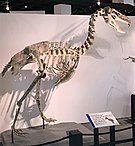Wikipedia:Today's featured article/August 27, 2022
Kelenken is a genus of phorusrhacid, an extinct group of large, predatory birds, which lived in what is now Argentina about 15 million years ago. The only known specimen was discovered by high school student Guillermo Aguirre-Zabala in Patagonia, and was made the holotype of the new genus and species Kelenken guillermoi in 2007. The generic name references a spirit in Tehuelche mythology, and the specific name honors its discoverer. The holotype consists of a nearly complete skull, a lower leg bone and a toe bone. The discovery of Kelenken clarified the anatomy of large phorusrhacids: flightless birds with long hind limbs, small wings, huge skulls and hooked beaks. At 716 mm (28.2 in) long, the skull of Kelenken is the largest known of any bird. Kelenken is thought to have been about 3 m (10 ft) tall and exceeded 100 kg (220 lb) in weight. It differs from its relatives in its larger size, length of its beak and details of its skull. It is thought to have been a fast-running ground predator. (Full article...)

